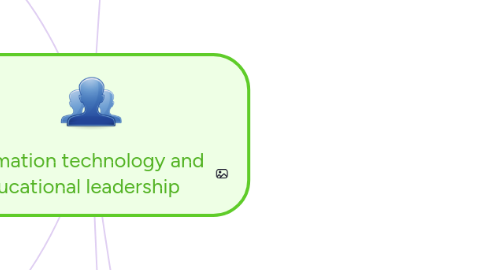
1. Change
1.1. understand change:theories of change and sustainability
1.1.1. Three models of change
1.1.1.1. Rogers, E. M. (2003). Diffusion of innovation
1.1.1.1.1. Four main elements
1.1.1.2. Hargreaves, D. H. (2003). Educational epidemic
1.1.1.2.1. Five types of transformation
1.1.1.3. Law, Yuen & Fox (2011). An Ecological Metaphor
1.1.1.3.1. A conceptual and practical framework for broad-based research in education.
1.1.1.3.2. Focus attention on:
1.1.1.3.3. Relationship
1.1.2. Change process in three region
1.1.2.1. Ontario
1.1.2.2. Alberta
1.1.2.3. Finland
1.1.2.3.1. PHASE
1.1.2.3.2. KEY FACTORS
1.1.2.3.3. GOAL
1.2. ICT and school leadership for change
1.2.1. Definition——leadership
1.2.1.1. School leaders are those persons, occupying various roles in the school, which provide direction and exert influence in order to achieve the school’s goals
1.2.2. The importance of leadership
1.2.2.1. Accountable
1.2.2.2. Complexity
1.2.3. Six core areas of leadership
1.2.3.1. Strategic Direction and Policy Environment
1.2.3.2. Learning,Teaching and Curriculum
1.2.3.3. Teacher professional growth and development
1.2.3.4. Staff and Resources Management
1.2.3.5. Quality Assurance and accountability
1.2.3.6. External communication and connection to the outside world
1.2.4. Two framework for ICT-enabled innovation learning
1.2.4.1. SCALE CCR: A mapping framework
1.2.4.2. Mapping Framework of etwining
1.2.5. Sustainable leadership
1.2.5.1. Definition
1.2.5.2. Seven Principles
2. E-leadership
2.1. Strategic e-Leadership: building architectures for learning and innovation
2.1.1. Strategic leadership of ICT
2.1.1.1. School level
2.1.1.1.1. Resource
2.1.1.1.2. Management
2.1.1.2. Classroom level
2.1.1.2.1. Teacher
2.1.1.2.2. Student
2.1.2. Architecture of learning( for teacher )
2.1.2.1. Model picture
2.2. ICT implementation and e-Leadership: change as multilevel and interconnected in the educational ecology
2.2.1. ICT Implementation in Hong Kong
2.2.1.1. Stakeholders comments
2.2.1.1.1. School leader
2.2.1.1.2. Teacher
2.2.1.1.3. Student
2.2.1.1.4. Parents
2.2.1.2. Barriers & Challenges
2.2.1.2.1. First-Order barriers
2.2.1.2.2. Second-Order barriers
2.2.2. 3 papers
2.2.2.1. Central forces shaping educational leadership
2.2.2.1.1. Changing school demographics
2.2.2.1.2. Hybrid school governance
2.2.2.1.3. Holding schools accountable
2.2.2.1.4. Developing teacher professionalism
2.2.2.2. Recurring dilemmas of educational leadership
2.2.2.2.1. Leading and managing:proposing and implementing
2.2.2.2.2. Cultivating the system and watching the environment
2.2.2.2.3. Participatory decision making and individual authority
2.2.2.3. Where to next for Educational leadership
2.2.2.3.1. Binaries
2.2.2.3.2. Hybridity
2.2.2.3.3. Configuration
2.2.2.3.4. Hybrid educational leadership configuration
2.2.2.3.5. Towards educational leadership capabilities
2.2.3. ICT in the Global Biosphere of Education
2.2.3.1. picture
2.2.3.2. Teacher leadership in E-Learning
2.2.3.2.1. Teacher as a leader
2.2.4. School routines provide an important mechanism for sustaining leadership
